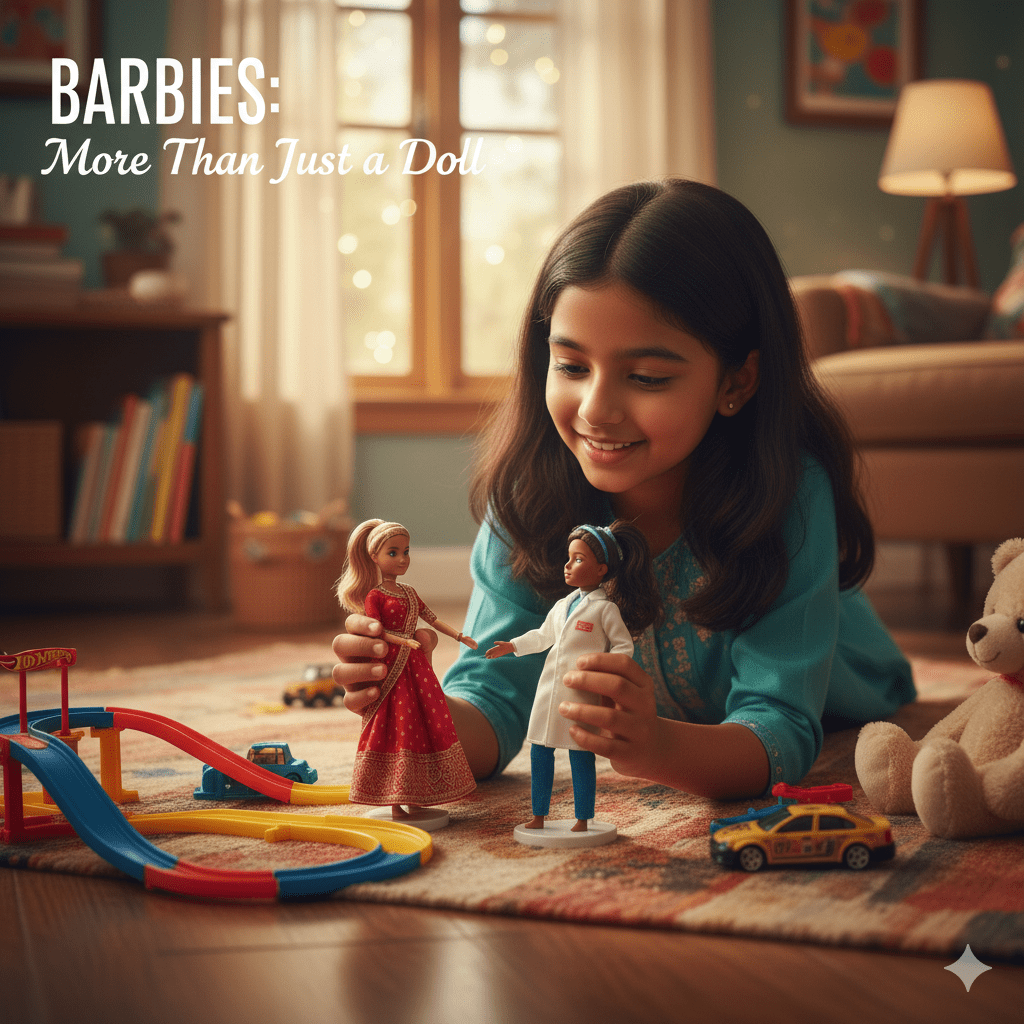Every parent holds a cherished memory of their childhood toys, and for many, that magic was embodied by a Barbie. As you search for the perfect dolls for your child today, balancing treasured memories with modern parenting goals is key. You might wonder: Are Barbies still relevant? And more importantly, Which Barbies are best for my child’s development? At ZaminoToys, we understand that finding the right toys means blending nostalgia with solid, modern parenting insights. This comprehensive guide will explore why Barbies are not just iconic dolls but powerful toys for learning, creativity, and self-expression, even in 2025. We’ll explore their incredible evolution, address common concerns, and show you exactly why a Barbie is a truly valuable addition to your child’s collection, offering far more than just surface-level fun. Forget the old notions; today’s Barbies are designed to inspire, educate, and empower, perfectly reflecting the diverse, ambitious world our children are growing up in.
The Inspiring Origin: Who Invented the Barbie Doll?
Every iconic toy has a great origin story, and the Barbie doll is no exception. Knowing the history of Barbies is key to appreciating her lasting impact. The Barbie doll was not created by a design committee, but by an inspiring woman named Ruth Handler, the co-founder of the American toy company, Mattel.
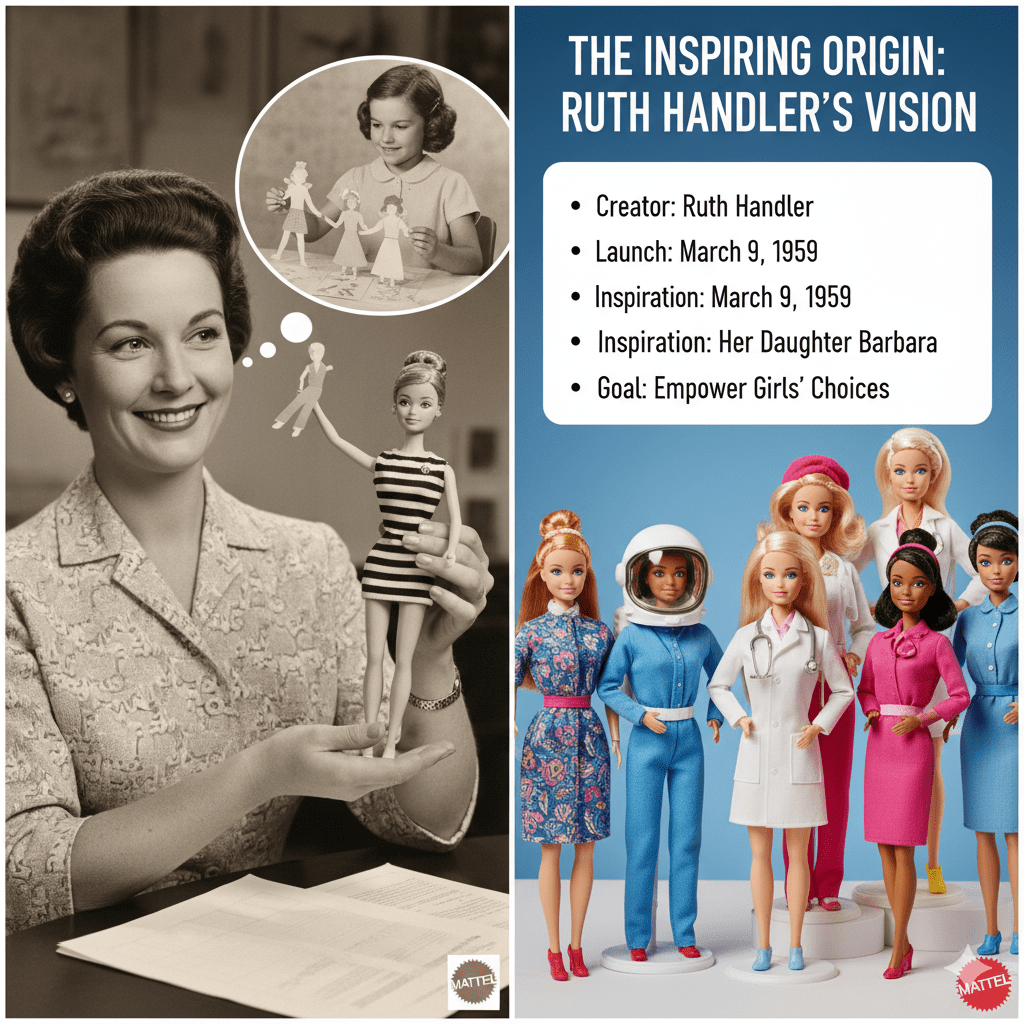
When Did Barbies Start?
The Barbie story began on March 9, 1959, when she was officially introduced at the American International Toy Fair in New York. This date is now recognized as her official birthday.
The Problem Barbie Solved
Before Barbie, most dolls were baby figures that encouraged little girls to practice nurturing and caregiving. Ruth Handler noticed that her daughter, Barbara (who Barbie is named after), preferred playing with adult paper dolls, giving them careers and complex narratives. Handler realized there was a gap in the toy market: there were no dolls that allowed girls to imagine their future selves.
Handler’s insight was revolutionary: she wanted to create a three-dimensional doll that could inspire girls to be anything they wanted. She famously said, “My whole philosophy of Barbie was that through the doll, the little girl could be anything she wanted to be. Barbie always represented the fact that a woman has choices.”
Key Facts to Know
Why Barbies Matter in Your Child’s Play World
As parents, we’re always seeking toys that offer more than fleeting entertainment. We want playthings that engage, educate, and evolve with our children. So, why do Barbies continue to hold a special place in the world of dolls and play? The truth is, Barbies are incredibly versatile toys that can contribute significantly to a child’s development in various ways. They provide a unique platform for imaginative play, helping children explore social roles, emotions, and future aspirations. From developing fine motor skills through dressing and accessorizing to building complex narratives with multiple Barbies, these dolls are far from passive objects. Many parents look for toys that offer longevity and diverse play opportunities, and Barbies fit this bill perfectly. When considering a toy shop near me for quality dolls, understanding the value that Barbies bring can guide your choice towards impactful play.
The Evolution of Barbies: From Fashion Icon to Role Model
The Barbie doll has undergone a remarkable transformation since her debut in 1959. Once primarily known for fashion and glamour, Barbies today represent an astonishing array of professions, body types, skin tones, and abilities. You might be surprised to learn about the sheer diversity now available, making Barbies more reflective of the real world than ever before. This evolution isn’t just cosmetic; it’s a conscious effort to ensure these dolls inspire children to see themselves in limitless roles.
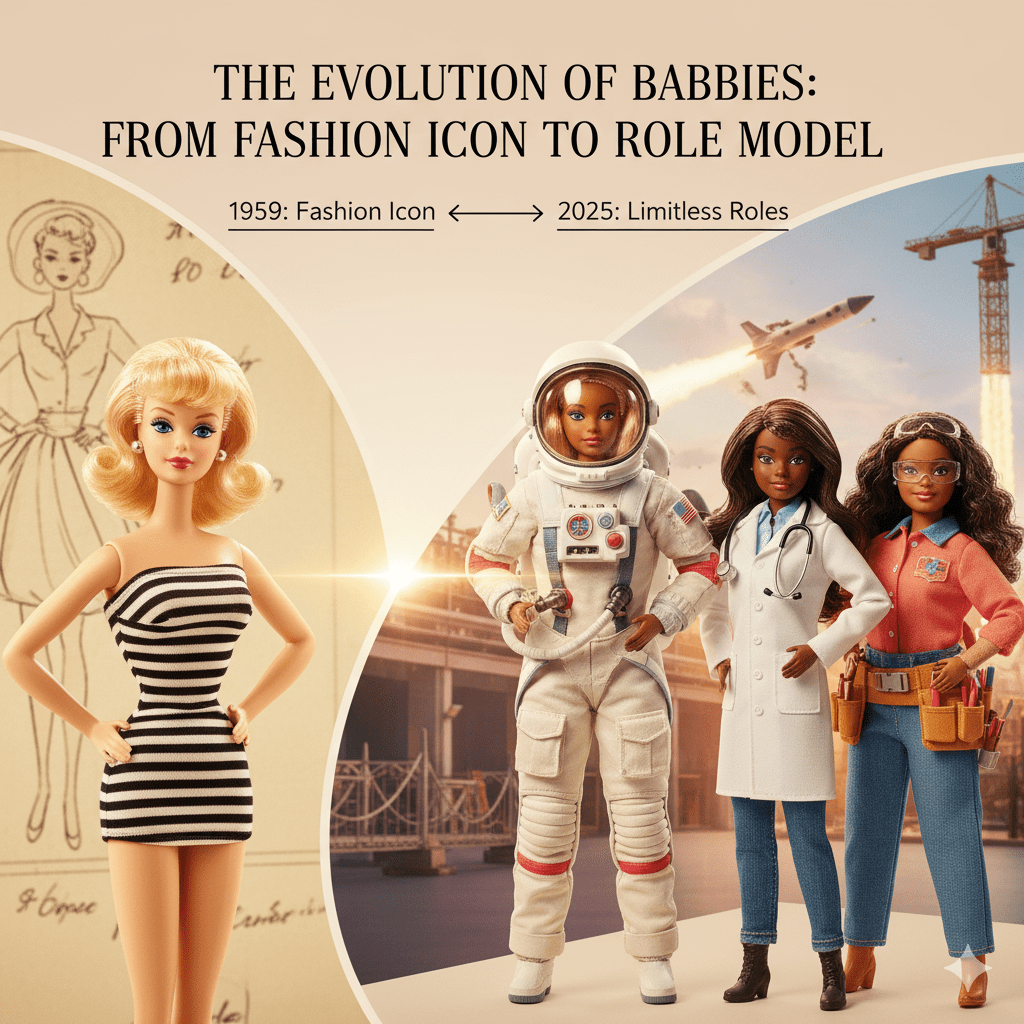
Here’s what parents should know about modern Barbies:
- Diverse Careers: Today’s Barbies have explored over 200 careers! From astronaut Barbies and doctor Barbies to engineers, scientists, and even presidential candidates, these dolls encourage children to dream big and see themselves in any profession they choose. This significantly broadens the scope of imaginative play beyond traditional roles often associated with dolls.
- Inclusive Body Types: Understanding the importance of body positivity, Mattel introduced Barbies with different body shapes – tall, petite, and curvy. This move helps children develop a healthier body image and realize that beauty comes in many forms, challenging the singular ideal once projected by the original Barbie doll.
- Vast Skin Tones & Hair Textures: Reflecting the global diversity, Barbies now come with numerous skin tones, eye colors, and hair textures, including dolls with vitiligo, wheelchairs, and hearing aids. This inclusivity helps all children find a Barbie that looks like them or their friends, fostering empathy and understanding.
- Cultural Representation: You can find Barbies inspired by various cultures and historical figures, including many representing Indian heritage. These dolls can be powerful tools for teaching children about different traditions and celebrating diversity.
This comprehensive update makes Barbies not just pretty dolls but powerful educational toys. As UNICEF emphasizes the importance of play in fostering respect for diversity, these inclusive Barbies are directly aligned with such developmental goals.
Expert Insights: How Barbies Nurture Growth
You might wonder, beyond the fun and fashion, what are the concrete developmental benefits of playing with Barbies? Child development experts and psychologists highlight several key areas where dolls like Barbies excel as valuable toys.
Developmental Benefits of Playing with Barbies:
- Imagination and Creativity: This is perhaps the most significant benefit. When children play with Barbies, they aren’t just playing with a doll; they’re creating entire worlds. They invent stories, dialogues, and scenarios, whether it’s a space mission for an astronaut Barbie or a fashion show for a designer Barbie. This narrative play is crucial for developing creative thinking and problem-solving skills.
- Social and Emotional Development:
- Role-Playing: Barbies allow children to explore different social roles and situations. They can mimic real-life interactions, practice communication, and understand different perspectives. This is invaluable for developing empathy.
- Emotional Expression: Children often project their feelings and experiences onto their dolls. A Barbie can become a confidante, helping a child process emotions, fears, or aspirations in a safe, imaginative space.
- Language and Communication Skills: As children create narratives for their Barbies, they naturally expand their vocabulary and improve their storytelling abilities. They practice speaking, listening (to their own internal monologue or a playmate), and even negotiation during shared play.
- Fine Motor Skills: Dressing Barbies, styling their hair, and manipulating tiny accessories (like those found with Hot Wheels cars sets for their Barbie-themed garages) all require precise hand-eye coordination and dexterity. This refines fine motor skills essential for writing and other daily tasks.
- Problem-Solving: Deciding how Barbies will achieve a goal in their imaginary world – whether it’s designing an outfit or navigating a tricky situation – involves critical thinking and problem-solving.
- Understanding the World: Through playing with diverse Barbies in various careers and backgrounds, children can better understand the world around them, different cultures, and diverse professions.
According to research, imaginative play with dolls activates brain regions associated with social information processing and empathy, regardless of who is playing. This underscores that Barbies are more than just a pretty face; they are potent tools for brain development.
Practical Tips: Choosing and Playing with Barbies
You’re ready to dive into the world of Barbies! But how do you choose the right ones, and how can you maximize their developmental benefits? Here’s a practical guide from ZaminoToys to help you navigate the vast selection and encourage enriching play. When you visit a toy shop near me or browse online, keep these tips in mind.
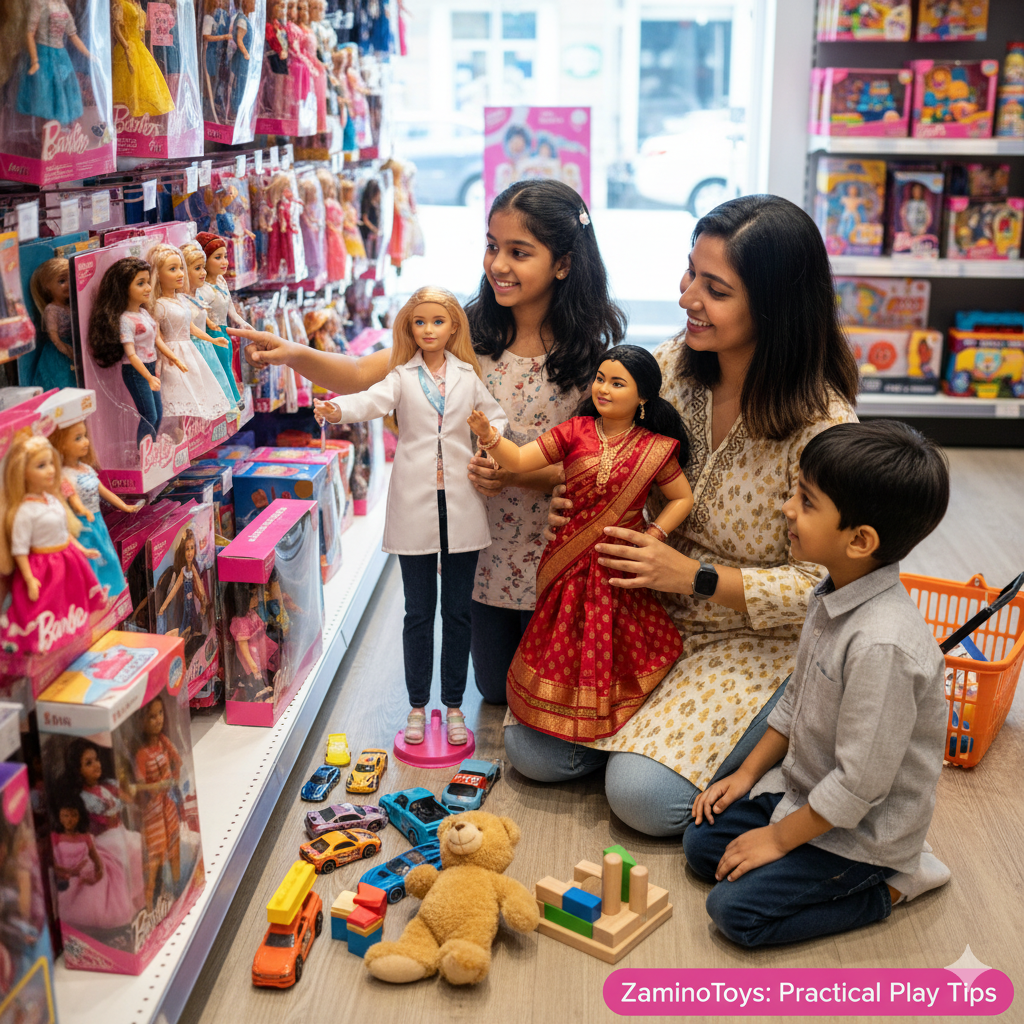
Choosing the Right Barbies for Your Child:
- Consider Interests: What is your child passionate about? If they love animals, look for a vet Barbie or a Barbie with pets. If they love space, an astronaut Barbie would be perfect. Tailoring the Barbies to their interests will spark more engaged play.
- Embrace Diversity: Actively choose Barbies with different skin tones, hair textures, body types, and abilities. This fosters inclusivity and helps your child understand and appreciate the beautiful diversity of the world.
- Explore Careers: Introduce Barbies in different professions. This subtly broadens your child’s horizons and encourages them to dream about what they can be.
- Look for Quality Accessories: While the Barbie doll is key, accessories like clothes, furniture, and vehicles (like Hot Wheels cars that might fit a Barbie garage or play set) enhance play scenarios. Ensure these are durable and safe.
- Check Age Recommendations: Always adhere to the manufacturer’s age guidelines, especially for Barbies with small accessories, to prevent choking hazards.
Maximizing Play with Barbies:
- Encourage Storytelling: Instead of just providing the Barbies, encourage your child to tell you the story of what their dolls are doing. Ask open-ended questions like, “Where are your Barbies going today?” or “What challenge are they facing?”
- Mix & Match: Don’t limit play to just Barbies. Integrate them with other toys! Their Barbies could drive their Hot Wheels cars, visit a teddy bear in its home, or even interact with other action figures. This expands imaginative possibilities.
- DIY Accessories: Get creative! Help your child make clothes for their Barbies from scrap fabric, build furniture from cardboard, or design a mini-world. This boosts creativity and fine motor skills.
- Join the Play: Occasionally, sit down and play with your child and their Barbies. You can introduce new vocabulary, model positive social interactions, or help them solve a “problem” their Barbies are facing.
- Discuss Diverse Roles: Use the diverse Barbies to spark conversations about different cultures, jobs, and abilities, fostering understanding and empathy.
Real-Life Connections: Barbies in Indian Homes
In Indian homes, dolls have always been cherished toys, from traditional fabric dolls to modern playthings. Barbies have seamlessly integrated into this rich play culture, often taking on unique roles. You’ll find many Indian parents using Barbies not just for global role-play but also to teach about Indian traditions. A Barbie might be dressed in a miniature saree for a Diwali celebration, or she might be the lead character in a story about a family wedding.
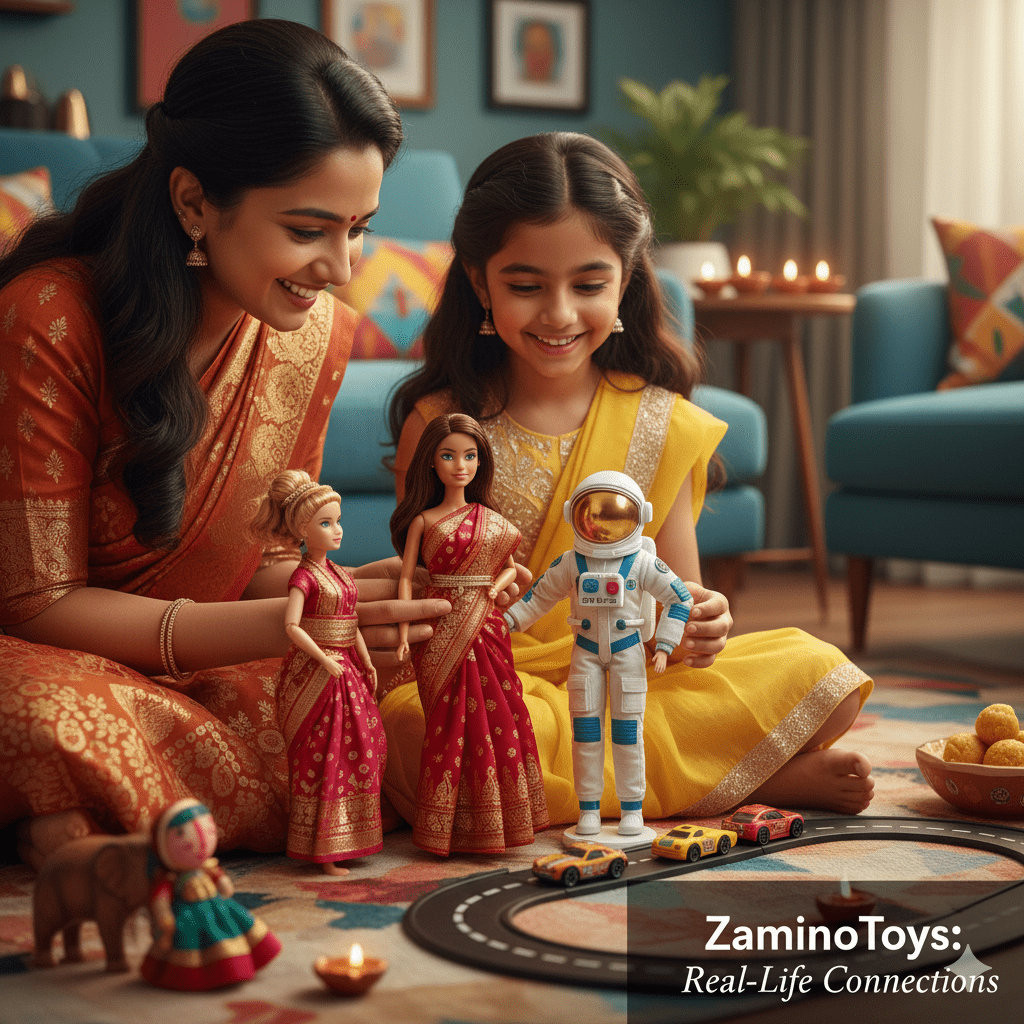
Parents often express how Barbies help their children explore aspirations that blend cultural identity with modern dreams. An Indian doctor Barbie can inspire conversations about healthcare and community service, while a fashionista Barbie might spark interest in traditional Indian textiles and designs. The inclusivity of modern Barbies, with various skin tones and even dolls wearing traditional outfits, makes it easier for Indian children to see themselves and their heritage reflected in their toys. This blend of tradition and modernity, much like the fusion wear trend in kids’ fashion, makes Barbies incredibly relevant and powerful in today’s Indian household.
Common Concerns About Barbies (and Why Modern Barbies Address Them)
You might have heard or even held some reservations about Barbies based on past criticisms. It’s natural for parents to be cautious about the toys their children play with. Let’s address some of these common concerns and see how modern Barbies have evolved to alleviate them.
- Concern 1: Unrealistic Body Image:
- Modern Barbies’ Answer: As mentioned, Barbies now come in original, petite, tall, and curvy body types, along with varying breast sizes and waistlines. This diverse representation helps children understand that there isn’t one “ideal” body shape. The focus has shifted from an aspirational physique to aspirational roles and achievements.
- Concern 2: Promoting Stereotypes (Gender/Career):
- Modern Barbies’ Answer: The vast array of careers (over 200!) for Barbies directly combats career stereotypes. From engineers and doctors to chefs and astronauts, Barbies show girls and boys that there are no limits to what they can achieve. Furthermore, the push for gender-neutral play means that boys are also encouraged to play with dolls, fostering empathy and caregiving skills.
- Concern 3: Focus on Consumerism/Fashion:
- Modern Barbies’ Answer: While fashion remains a core part of Barbie’s identity, the emphasis has expanded significantly. The current marketing often highlights empowerment, creativity, and career success rather than just glamour. Parents can guide play to focus on the narrative and character development, using fashion as a tool for expression rather than the sole purpose of the toy.
- Concern 4: Lack of Diversity:
- Modern Barbies’ Answer: This is perhaps the area of greatest improvement. Barbies now represent virtually every skin tone, hair texture, and ethnicity, and include dolls with disabilities (e.g., in wheelchairs, with prosthetic limbs). This robust diversity ensures that more children can see themselves in their dolls and learn to celebrate differences.
By actively choosing from the diverse range of Barbies available today, you can ensure that your child’s play experience is inclusive, empowering, and aligns with your family’s values. When you visit a toy shop near me, take a moment to explore these new, inclusive lines.
Final Thoughts: Barbies – A Timeless Toy for Modern Kids
As we’ve explored, Barbies have successfully transformed from a simple fashion doll into a powerful symbol of empowerment and diversity. They are not just plastic figures; they are canvases for imagination, tools for social-emotional growth, and mirrors reflecting a more inclusive world. For parents navigating the vast world of toys, Barbies offer a unique blend of nostalgia, modern relevance, and genuine developmental benefits. Whether your child is creating an epic story with an astronaut Barbie, designing a home for their diverse dolls, or having a race with their Hot Wheels cars and Barbies at the finish line, the play possibilities are truly endless.
At ZaminoToys, we believe in helping you choose toys that spark joy and foster growth. Don’t hesitate to rediscover the magic of Barbies and see how these iconic dolls can inspire your child to dream without limits.
Curious About How to choose toys acording to age Read Our :- Age-wise-toy-guide
FAQ Section
Q1: Are Barbies still popular with kids today?
A1: Yes, Barbies remain highly popular globally and in India. Modern Barbies with diverse careers, body types, and inclusive features resonate strongly with today’s children and parents, making them one of the most sought-after dolls in any toy shop near me.
Q2: What age are Barbies appropriate for?
A2: Most Barbies are recommended for children aged 3 years and up, primarily due to small parts and accessories that can pose a choking hazard for younger children. Always check the specific Barbie doll’s age recommendation on the packaging.
Q3: How do Barbies help a child’s development?
A3: Playing with Barbies significantly boosts imagination, creativity, social-emotional skills (through role-playing), language development, and fine motor skills. The diverse range of Barbies also helps children understand and appreciate different cultures and professions.
Q4: Can boys play with Barbies?
A4: Absolutely! Play has no gender. Encouraging boys to play with dolls like Barbies can foster empathy, caregiving skills, social understanding, and imaginative storytelling—all crucial developmental benefits.
Q5: Where can I find diverse Barbies in India?
A5: You can find a wide range of diverse Barbies, including various skin tones, body types, and careers, at major online retailers, large department stores, and specialized toy shop near me that stock international brands. ZaminoToys.in also features recommendations for diverse Barbies.
Read Our other Blogs:-

